Page 188 of 274
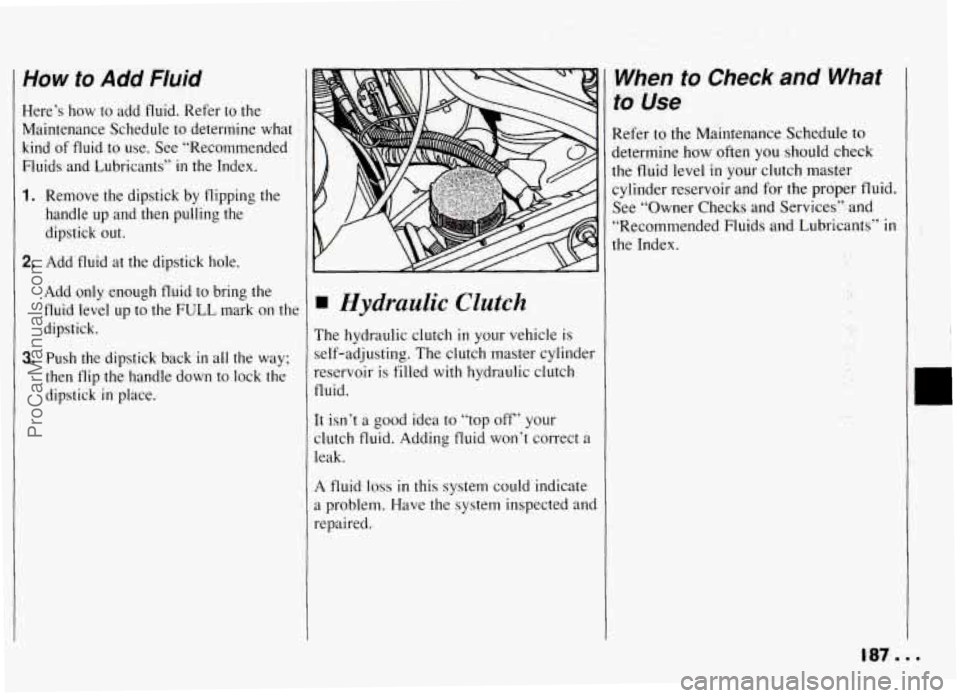
How to Add Fluid
Here’s how to add fluid. Refer to the
Maintenance Schedule to determine what
kind of fluid
to use. See “Recommended
Fluids and Lubricants”
in the Index.
1. Remove the dipstick by flipping the
handle up and then pulling the
dipstick out.
2. Add fluid at the dipstick hole.
Add only enough fluid to bring the
fluid level up to the
FULL mark on the
dipstick.
3. Push the dipstick back in all the way;
then flip the handle down to lock the
dipstick
in place.
Hydraulic Clutch
The hydraulic clutch in your vehicle is
self-adjusting. The clutch master cylinder
reservoir is filled with hydraulic clutch
fluid.
It isn’t a good idea to “top off’ your
clutch fluid. Adding fluid won’t correct a
leak.
A fluid loss in this system could indicate
a problem. Have the system inspected and
repaired.
When to Check and What
to Use
Refer to the Maintenance Schedule to
determine how often you should check
the fluid level
in your clutch master
cylinder reservoir and for the proper fluid.
See “Owner Checks and Services” and
“Recommended Fluids and Lubricants”
in
the Index.
187...
ProCarManuals.com
Page 196 of 274
Headlight Bulb
Replacement
For the type of bulb, see “Replacement
Bulbs”
in the Index.
1. On the driver’s side only, unscrew the
butterfly fastener. Then lift the plate.
Both Sides:
2. Twist the bulb assembly
counterclockwise 1/6 turn and pull out
the bulb assembly.
3. Unclip the bulb assembly from the
wiring harness.
4. Reverse steps 1-3 to replace the bulb
assembly and headlight housing.
195...
ProCarManuals.com
Page 214 of 274
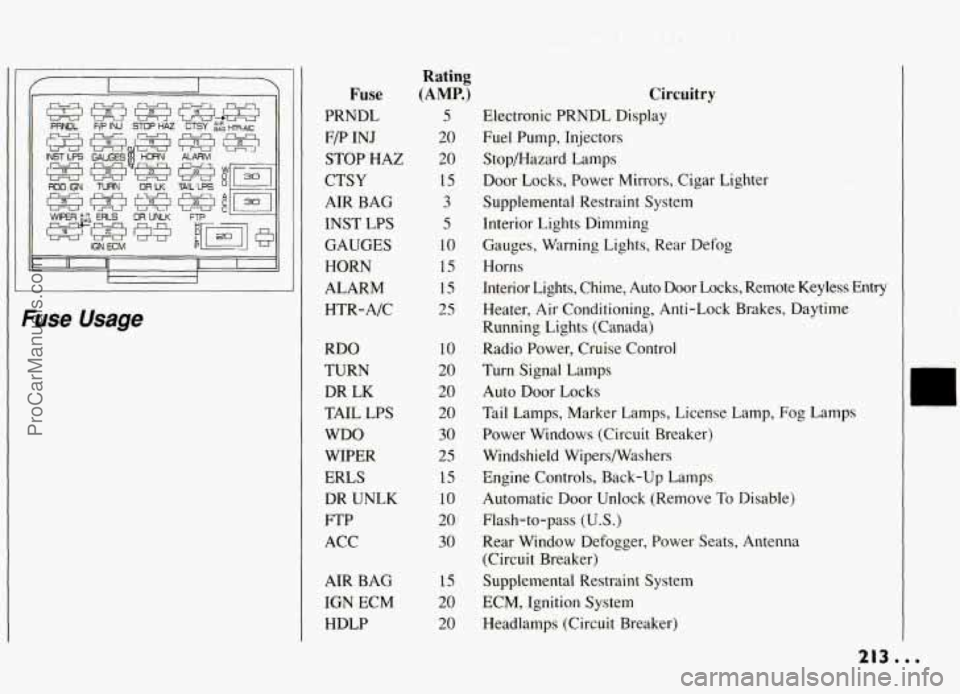
IC
Fuse Usage
Fuse
PRNDL
F/P INJ
STOP HAZ
CTSY
AIR BAG
INST
LPS
GAUGES HORN
ALARM
HTR-A/C
RDO
TURN
DR LK
TAIL LPS
WDO WIPER
ERLS DR UNLK
FTP
ACC
AIR BAG
IGN ECM
HDLP
Rating
(AMP. )
5
20
20
15
3
5
10
15
15
25
10
20
20
20
30
25
15
10
20,
30
15
20
20
Circuitry
Electronic PRNDL Display
Fuel Pump, Injectors
Stop/Hazard Lamps
Door Locks, Power Mirrors, Cigar Lighter
Supplemental Restraint System
Interior Lights Dimming
Gauges, Warning Lights, Rear Defog
Horns
Interior Lights, Chime, Auto Door Locks, Remote Keyless Entry Heater, Air Conditioning, Anti-Lock Brakes, Daytime
Running Lights (Canada)
Radio Power, Cruise Control
Turn Signal Lamps
Auto Door Locks
Tail Lamps, Marker Lamps, License Lamp, Fog Lamps
Power Windows (Circuit Breaker)
Windshield Wipers/Washers
Engine Controls, Back-up Lamps
Automatic Door Unlock (Remove
To Disable)
Flash-to-pass
(U.S.)
Rear Window Defogger, Power Seats, Antenna
(Circuit Breaker)
Supplemental Restraint System
ECM, Ignition System
Headlamps (Circuit Breaker)
1
213 b
ProCarManuals.com
Page 215 of 274
Service & Appearance Care
I Headlight Wiring
The headlight wiring is protected by a
circuit breaker in the fuse block. An
electrical overload
will cause the lights to
go on and off or,
in some cases, to remain
off. If this happens, have your headlight
system checked right away.
I
Windshield Wipers
The windshield wiper motor is protected
~y a circuit breaker and a fuse. If the
notor overheats due to heavy snow, etc.,
:he wiper will stop until the motor
cools.
[f the overload is caused by some
:lectrical problem, have
it fixed.
Power Windows and Other
Power Options
Clircuit breakers in the fuse panel protect
:he power windows and other power
iccessories. When the current load is too
leavy, the circuit breaker opens and
:loses, protecting
the circuit until the
aroblem is fixed.
. . . 214
ProCarManuals.com
Page 234 of 274
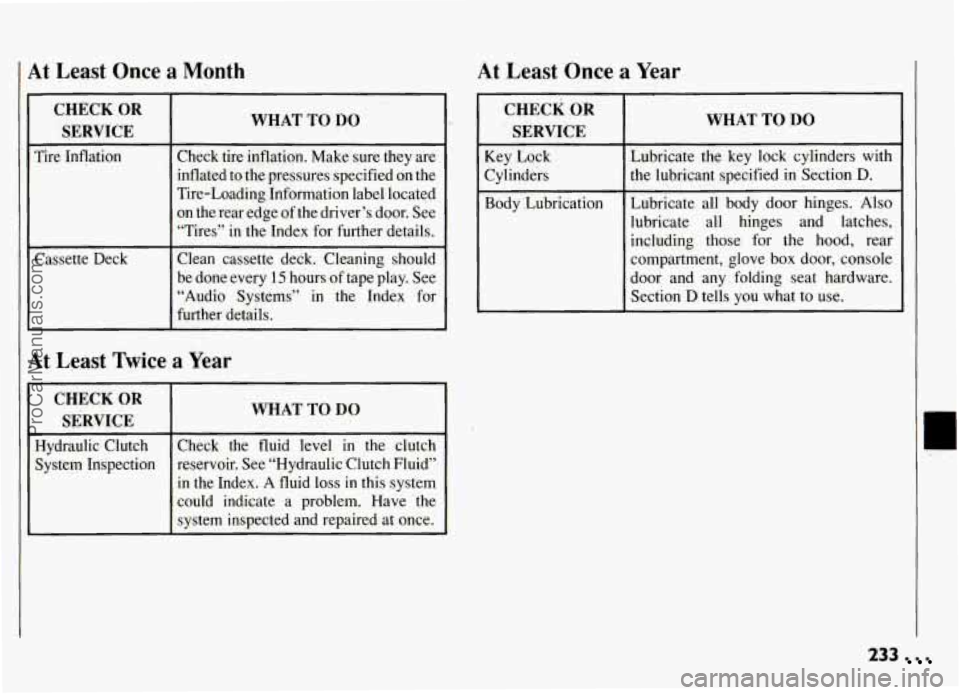
At Least Once a Month At Least Once a Year
WHAT TO DO I’
Tire Inflation Check tire inflation. Make sure they are
inflated to the pressures specified on the
Tire-Loading Information label located
on the rear edge of the driver’s door. See
“Tires” in the Index for further details.
Cassette Deck Clean cassette deck. Cleaning should
be done every
15 hours of tape play. See
“Audio Systems” in the Index for
further details.
I I
Lt Least Twice a Year
SERVICE I
WHAT TO DO
Hydraulic Clutch Check the fluid level in the clutch-
System Inspection reservoir. See “Hydraulic Clutch Fluid”
in the Index.
A fluid loss in this system
could indicate a problem. Have ‘the
system inspected and repaired at once.
CHECK OR
SERVICE
Key Lock
Cylinders
Body ‘Lubrication
WHAT TO DO
Lubricate the key lock cylinders with
the lubricant specified in Section
D.
Lubricate all body door hinges. Also
lubricate all hinges and latches,
including those for the hood, rear
compartment, glove box door, console
door and any folding seat hardware.
Section
D tells you what to use.
I
233
ProCarManuals.com
Page 235 of 274
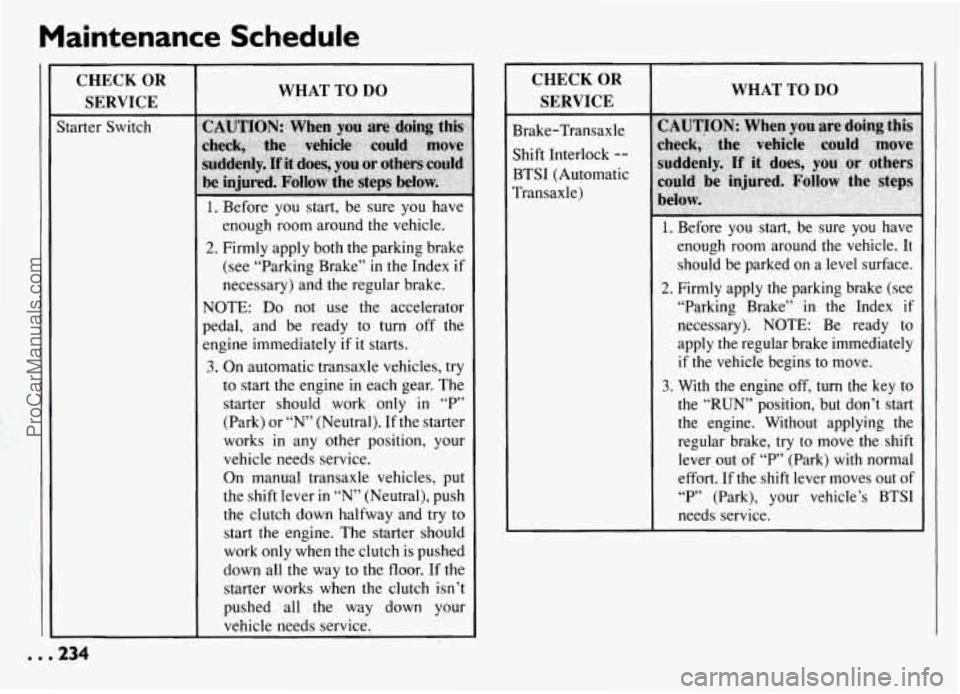
Maintenance Schedule
CHECK OR
SERVICE
Starter Switch
WHAT TO DO
1. Before you start, be sure’ you have
enough room around the vehicle.
2. Firmly apply both the parking brake
(see “Parking Brake” in the Index if
necessary) and the regular brake.
NOTE: Do not use the accelerator
pedal, and be ready to turn off the
engine immediately if it starts.
3. On automatic transaxle vehicles, try
to start the engine in each gear. The
starter should work only
in “F’”
(Park) or “N” (Neutral). If the starter
works
in any other position, your
vehicle needs service.
On manual transaxle vehicles, put
the shift lever in “N” (Neutral), push
the clutch down halfway and
try to
start the engine. The starter should
work only when the clutch is pushed
down all the way to ‘the floor. If the
starter works when the clutch isn’t
pushed all the way down your
vehicle needs service.
CHECK OR
SERVICE
Brake-Transaxle
Shift Interlock
--
BTSI (Automatic
I‘ransaxle)
WHAT TO DO
1. Before you start, be sure you have
enough room around the vehicle. It
should be parked on a level surface.
2. Firmly apply the parking brake (see
“Parking Brake”
in the Index if
necessary). NOTE: Be ready to
apply the regular brake immediately
if the vehicle begins to move.
3. With the engine off, turn the key to
the “RUN” position, but don’t start the engine. Without applying the
regular brake, try to move the shift
lever out of
“P” (Park) with normal
effort. If the shift lever moves out of
“P’ (Park), your vehicle’s BTSI
needs service.
. . .234
ProCarManuals.com
Page 236 of 274
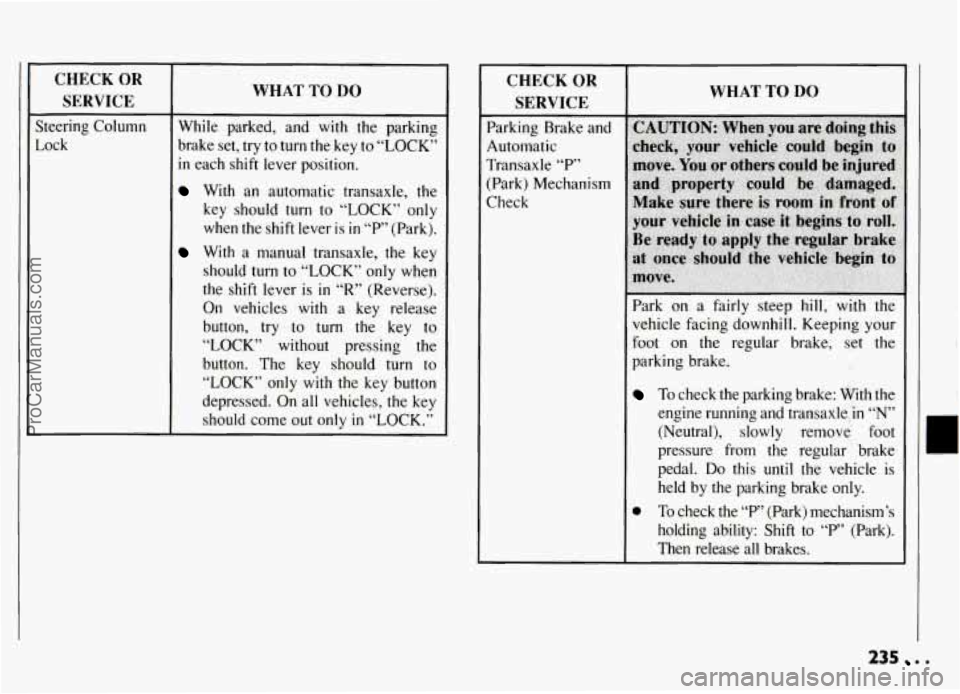
CHECK OR
SERVICE
Steering Column
Lock
WHAT TO DO
While parked, and with the parking
brake set, try to
turn the key to “LOCK”
in each shift lever position.
With an automatic transaxle, the
key should turn to “LOCK” only
when
the shift lever is in “P’ (Park).
With a manual transaxle, the key
should turn to “LOCK” only when
the shift lever is in “R” (Reverse).
On vehicles with a key release
button, try to turn the key to
“LOCK” without pressing the
button. The
key should turn to
“LOCK” only with the key button
depressed.
On all vehicles, the key
should come out only
in “LOCK.”
CHECK OR
SERVICE
Parking Brake and
Automatic
Transaxle
T“
(Park) Mechanism
Check
WHAT TO DO
cAuyoN:when, y.ou~are~~~doing.,~his’
check, your vehicle could begin to.
move. You or others could be injured:
and property
could be damaged.
Make sure there
is room in front of,
your vehicle in case it begins to roll.,:
Re ready to apply the regular brake
Park on a fairly steep hill, with the
vehicle facing downhill. Keeping your
foot
on the regular brake, set the
parking brake.
To check the parking brake: With the
engine running and transaxle in “N”
(Neutral), slowly remove foot
pressure from the regular brake
pedal.
Do this until the vehicle is
held by the parking brake only.
To check the “P’ (Park) mechanism’s
holding ability: Shift to
“P” (Park).
Then release all brakes.
235
ProCarManuals.com
Page 238 of 274
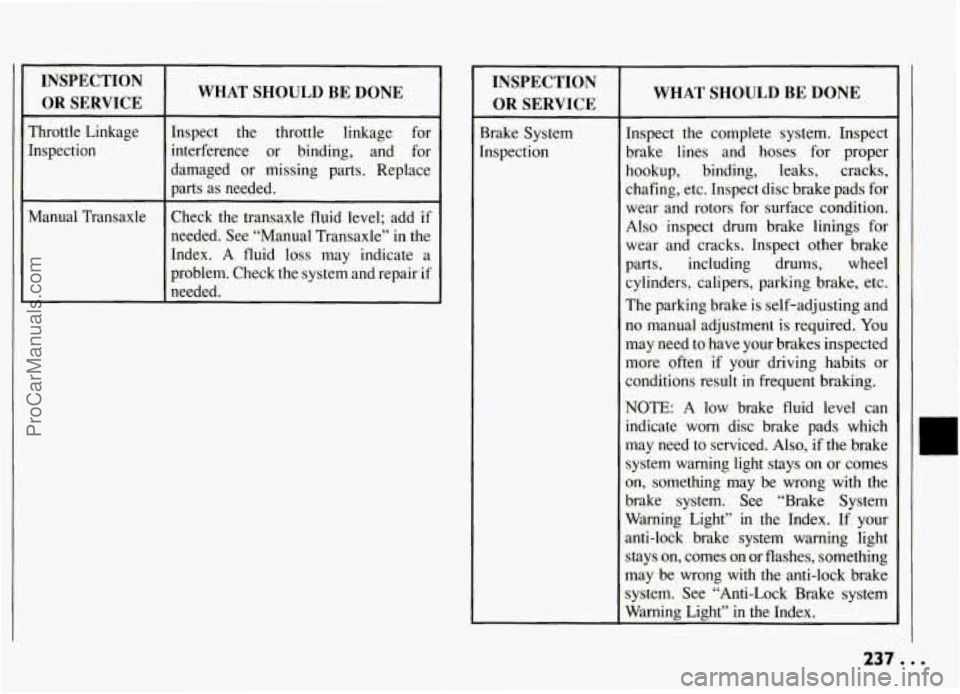
INSPECTION
OR SERVICE
Throttle Linkage
Inspection
Manual Transaxle
WHAT SHOULD BE DONE
Inspect the throttle linkage for
interference or binding, and for
damaged or missing parts. Replace
parts as needed.
Check the transaxle fluid level; add if
needed. See “Manual Transaxle” in the
Index.
A fluid loss may indicate a
problem. Check the system and repair if
needed.
INSPECTION
OR SERVICE
Brake System
Inspection
WHAT SHOULD BE DONE
Inspect the complete system. Inspect
brake lines and hoses for proper
hookup, binding, leaks, cracks,
chafing, etc. Inspect disc brake pads for
wear and rotors for surface condition.
Also inspect drum brake linings for
wear and cracks. Inspect other brake
parts, including drums, wheel
cylinders, calipers, parking brake, etc.
The parking brake is self-adjusting and
no manual adjustment is required. You
may need to have your brakes inspected
more often
if your driving habits or
conditions result
in frequent braking.
NOTE: A low brake fluid level can
indicate worn disc brake pads which
may need to serviced. Also, if the brake
system warning light stays
on or comes
on, something may be wrong with the
brake system. See “Brake System
Warning Light”
in the Index. If your
anti-lock brake system warning light
stays
on, comes on or flashes, something
may be wrong with the anti-lock brake
system. See “Anti-Lock Brake system
Warning Light” in
the Index.
237
ProCarManuals.com